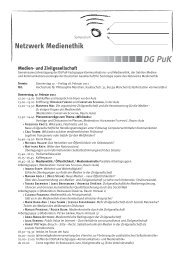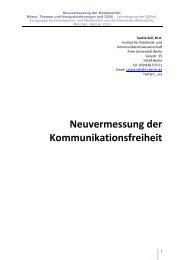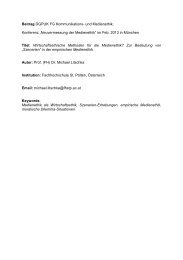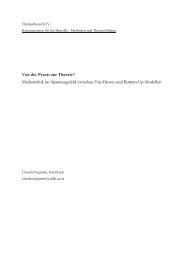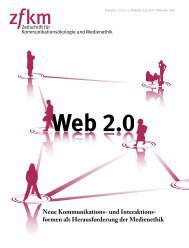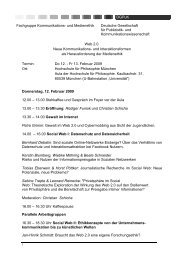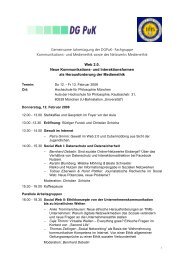Komplette Ausgabe 2010 - synpannier
Komplette Ausgabe 2010 - synpannier
Komplette Ausgabe 2010 - synpannier
Erfolgreiche ePaper selbst erstellen
Machen Sie aus Ihren PDF Publikationen ein blätterbares Flipbook mit unserer einzigartigen Google optimierten e-Paper Software.
Stefanie Pannier & Jeldrik Pannier _ Sein und Sollen im Produktionsprozess von Nachrichtenfotografien<br />
45 |<br />
Prinzipien des Unternehmens. Das Dokument beginnt<br />
mit den folgenden Ausführungen:<br />
»For more than a century and a half, men and women<br />
of The Associated Press have had the privilege of bringing<br />
truth to the world. They have gone to great lengths,<br />
overcome great obstacles – and, too often, made great and<br />
horrific sacrifices – to ensure that the news was reported<br />
quickly, accurately and honestly. Our efforts have been<br />
rewarded with trust: More people in more places get their<br />
news from the AP than from any other source. In the 21st<br />
century, that news is transmitted in more ways than ever<br />
before – in print, on the air and on the Web, with words,<br />
images, graphics, sounds and video. But always and in all<br />
media, we insist on the highest standards of integrity and<br />
ethical behavior when we gather and deliver the news.«<br />
(Associated Press 2006, S. 1)<br />
Dieser erste Absatz zeigt, dass sich AP primär an journalistischen<br />
und in diesem Sinne berufsethischen Werten<br />
orientiert. Die wahrheitsgetreue Unterrichtung der<br />
(Welt-)Öffentlichkeit, auf schnellstem und dennoch auf<br />
ehrlichem und akkuratem Weg, bildet den Kern. Die damit<br />
korrespondierenden Grundwerte lauten demnach:<br />
Wahrheit, Schnelligkeit, Aufrichtigkeit/Ehrlichkeit und<br />
Sorgfalt/Fairness. AP beschreibt ihre Position als Privileg<br />
und sieht sich, durch das entgegen gebrachte Vertrauen<br />
der Rezipienten bestätigt. Um dieses Privileg und das<br />
Vertrauen aufrecht zu erhalten, verspricht das Unternehmen,<br />
bei der Nachrichtenbeschaffung das höchste Maß<br />
an Integrität und ethischem Verhalten zu Grunde zu legen.<br />
Gleichzeitig wird in diesem Abschnitt auch deutlich,<br />
dass die Mitarbeiter des Unternehmens dafür einiges in<br />
Kauf nehmen und dabei gegeben Falls eigene Bedürfnisse<br />
zurück stellen (müssen). In der Darstellung wird<br />
dieser Aspekt hier aus Unternehmensperspektive stark<br />
heroisiert, dies kann sich aus Subjektperspektive aber<br />
auch anders darstellen.<br />
In der Einleitung werden des Weiteren die benannten<br />
Werte konkretisiert und in Handlungsnormen überführt.<br />
»That means we abhor inaccuracies, carelessness, bias or<br />
distortions.<br />
It means we will not knowingly introduce false information<br />
into material intended for publication or broadcast;<br />
nor will we alter photo or image content. Quotations<br />
must be accurate, and precise.<br />
It means we always strive to identify all the sources of<br />
our information, shielding them with anonymity only<br />
when they insist upon it and when they provide vital information<br />
(…).<br />
It means we don’t plagiarize.<br />
It means we avoid behavior or activities that create a<br />
conflict of interest and compromise our ability to report<br />
the news fairly and accurately, uninfluenced by any person<br />
or action.<br />
It means we don’t misidentify or misrepresent ourselves<br />
to get a story. When we seek an interview, we identify<br />
ourselves as AP journalists.<br />
It means we don’t pay newsmakers for interviews, to<br />
take their photographs or to film or record them.<br />
It means we must be fair. Whenever we portray someone<br />
in a negative light, we must make a real effort to obtain<br />
a response from that person. When mistakes are made,<br />
they must be corrected – fully, quickly and ungrudgingly.«<br />
(Associated Press 2006, S. 1)<br />
Mit diesen Praxisnormen werden die eher abstrakten<br />
Idealnormen fassbar gemacht und geben konkrete Handlungsanweisungen<br />
vor. Dass die Unternehmensleitsätze<br />
nur wirksam werden können, wenn alle Beteiligen auf allen<br />
Ebenen an ihnen festhalten bzw. im Alltag anwenden<br />
wird mit der folgenden Aussage verdeutlicht.<br />
»And ultimately, it means it is the responsibility of every<br />
one of us to ensure that these standards are upheld. Any<br />
time a question is raised about any aspect of our work, it<br />
should be taken seriously.« (Associated Press 2006, S. 1)<br />
Damit verweist das Papier auf die Verantwortung des<br />
Individuums ohne die Institution damit von ihrer Verantwortung<br />
auszuklammern.<br />
Abschließend werden Sanktionierungen bei nicht Befolgung<br />
der Leitsätze bzw. entsprechendem Fehlverhalten<br />
angeführt:<br />
»The policies set forth in these pages are central to the<br />
AP’s mission; any failure to abide by them is subject to review,<br />
and could result in disciplinary action, ranging from<br />
admonishment to dismissal, depending on the gravity of<br />
the infraction.« (Associated Press 2006, S. 1)<br />
Die darauf folgenden detaillierten Ausführungen beziehen<br />
sich auf konkrete Handlungsvorgaben für alle Bereiche<br />
und Tätigkeiten der Nachrichtenproduktion der<br />
Agentur. Diese gliedern sich u. a. in die Bereiche: Anonymous<br />
Sources, Audio, Bylines, Datelines, Fabrications,<br />
Graphics, Images, Obscienities, Profanities, Vulgarities,<br />
Privacy, Quotations, Responses, Conflicts Of Interest<br />
Wir werden uns im Folgenden auf die nähere Betrachtung<br />
der Ausführungen zum Bereich Foto und die damit<br />
verbundenen Vorgaben für die Arbeit in den Bildredaktionen<br />
beschränken.<br />
Der Umgang mit Fotografien wird in den Statement<br />
of News Values and Principles an verschiedenen Stellen<br />
thematisiert. Zusätzlich zu den bereits in der Einleitung<br />
gemachten Grundsatzvorgaben finden sich klare Handlungsempfehlungen<br />
und Vorschriften z. B. im Abschnitt<br />
Fabrications. »Nothing in our news report – words, photos,<br />
graphics, sound or video – may be fabricated (...) We do<br />
not ask people to pose for photos unless we are making<br />
a portrait and then we clearly state that in the caption.<br />
We explain in the caption the circumstances under which<br />
photographs are made.« (Associated Press 2006, S. 5)



